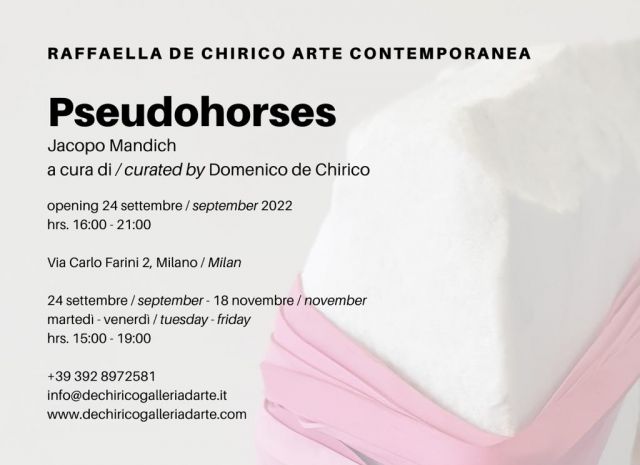Jacopo Mandich | PSEUDOHORSES
From 24/09/2022 To 09/12/2022

“Art must begin with consciousness and terminate in the unconscious, that is, objectively; the self is conscious with respect to production, unconscious with respect to the product.”
Friedrich Schelling
“Science describes things as they are; Art as they are felt, as they are felt to be.”
Fernando Pessoa
Roman by origin but Turinese by adoption, class of 1979, Jacopo Mandich graduated in sculpture from the Rome Academy of Fine Arts in 2005. In 2006 he won the Edgardo Mannucci prize. In 2015 he frequented the biennial specialization courses at the Academies of Fine Arts of Urbino and Turin and was the first Italian artist invited to the Ekaterinburg Biennial of Contemporary Art in Russia. In 2018 he frequented the post-graduate course in Sculpture at the Burg Giebichenstein Kunsthochschule at Halle, in Germany.
Poised between sensitive knowledge or opinion and intelligible knowledge or science, as well as between intellection or belief, the artistic research of Jacopo Mandich is based on the alchemical and energetic interaction running through matter, where wood, iron, stone, among other materials, come into contact with one another and create a muscular short-circuit capable of generating potent, vibrant and stunning sculptural constructs with the intention of investigating all those hidden and intangible energies underlying the movements of the human flux.
This new chapter in the artist’s exhibition career, entitled “Pseudohorses”, reflects on the contrast that is created between memory and reality in an ever vigil mental state oscillating between the dimension bound up with memory and that of the imagination. The title of the exhibition is composed of psèudo-, from the ancient Greek ψευδο, deriving from the root shared by ψευδής “false”, ψεῦδος “lie, falsehood”, and ψεύδομαι “to lie” and the English plural noun horses, a pretext for alluding to the animal kingdom in all its symbology, a fundamental and iconic realm in the processes of representation typical of ancient art, considered in its entirety, from the dawn of the so-called Mittel European society through to the present day. Here, the animal element is visibly brutalised in order to allude to all those mental processes that frequently call on the so-called archetypes, overcoming them and denouncing
every form of allusion that provides for the distortion of reality that becomes memory, the deformation of perception and the alteration of the cognitive map that often assimilates everything.
Memory, in fact, understood as the deformation of pure reality, which is destined to become simply a representation processed in a wholly personal key, and no longer adhering to the objectivity of things. This is how Mandich investigates the differences that exist between the imagination and reality, on a stage that is presented to us with reality becoming memory and human perception proving to be altered. The artist created “Pseudohorses” on the basis of this premise, with the layout divided into two hemispheres, between the external and interior areas of the gallery. Featuring in the external space are the so-called jackals, skilfully installed in the courtyard leading to the gallery entrance, with their positions not being immediately visible. This installation is intended to represent concealed memory, the memory that exists in the depths of consciousness, cradle of the subconscious. This sentiment, a kind of sensorial magnetism, manifests through sensations translatable in parallel as attraction or repulsion. The gallery’s internal exhibition space is instead pervaded by an army of soft toys that disturb the atmosphere. In this case, we find paradoxical contrasts that metaphorically allude to the relationship that exists between memory and reality. The element that recurs multiple times throughout the exhibition, albeit with diverse variations, is that of the teddy bear, an icon for all the archetypes perceptibly associated with habitual states of playfulness and irony. This symbol, familiar to all of us, is contextualised within the changes in the state of matter, mechanical changes like compression or dilation, concretizing mechanical and physical actions typical of matter itself, both a physical and metaphysical entity, which, examined from the metaphysical point of view, in fact, that is as the principle giving rise to corporeal becoming, as understood by Mandich, and in the words of the ancient Greek philosopher Plato, as written his famous dialogue entitled Timaeus, around 360 B.C., we can quietly and deliberately assert that: “We shall not be wrong in saying that is an invisible and formless being which receives all things and in some mysterious way partakes of the intelligible and is most incomprehensible.”



